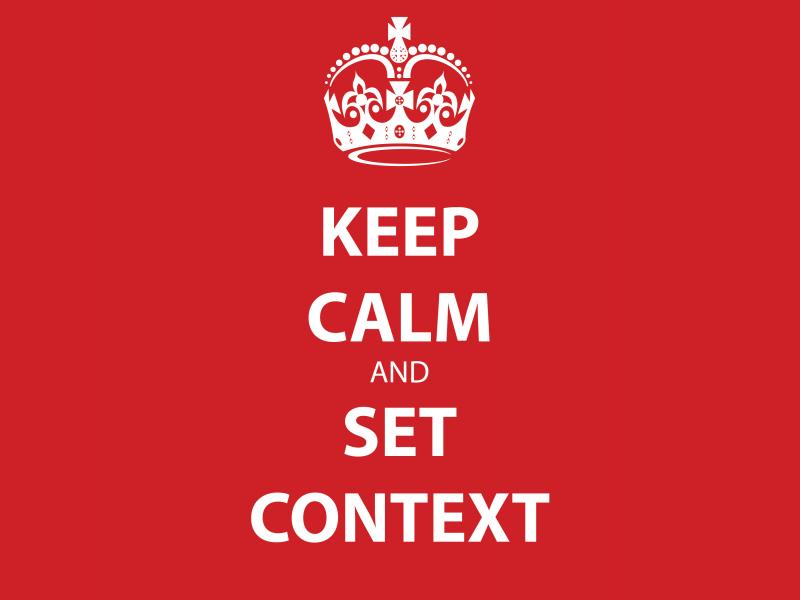19th October 2016
Set context, and carry on
This ought to be the mantra for all teachers, yet it is often one of the most challenging components of any language lesson: set it well, and the meaning and range of language students can use appropriately becomes suddenly more accessible; set it poorly, and you’ll have the students (and possibly yourself too!) scratching heads with puzzled looks.
But what is context?
Context, in terms of language teaching, relates to the who, where, what, why of any communication, and it is this that often determines what meaning is intended to be communicated, and which meanings (yes, plural!) could potentially be interpreted accurately from that communication….because remember, communication is a two-way process most of the time, involving a communicator, and the receiver of the message.
To clarify this, think back to the classic annoying dad joke: a child asks his dad “Dad, can I have some milk?” to which the dad replies, “I don’t know, can you?” (cue eye-rolls).
The sarcasm in this exchange lies in the fact that the verb can fulfills a range of different meanings. Consider:
- I can swim (ability)
- You can’t come in without a ticket (permission)
- It can’t be Thursday already! (possibility)
- Can I have two beers please? (Request)
So in our example of the dad joke above, the child has used can to communicate permission, where the dad has responded using can to express ability or possibility.
Before the language teacher in you wants to step into the conversation between the child and his father and calmly point out that confusing the intrinsic and extrinsic meanings of modal verbs is no laughing matter, the key point to make is simply that in English one form (e.g. a verb, a phrase, an idiom) can have many functions.
So, test yourself out
Try this mini test out for yourself – how many different meanings could these phrases have:
- It’s cold in here!
- The police are coming!
- Coffee?
- Sorry, I don’t have any.
For each of the possible meanings you identify, ask yourself: who is speaking? What are they trying to communicate? Why are they trying to say this? Where are they talking?
This is context
The answers to these questions are effectively the possible contexts of the phrases in the mini test above. As you can see, depending on the meaning of each phrase, the situation defines what the possible meanings each phrase could logically take on: that is to say, if you want to use a particular phrase in your lessons to show students how to make requests, for example, then the students have to be able to locate that phrase in a fairly specific communicative situation in order for the meaning you have planned to be accurate and identifiable.
The practical implication for your teaching is that context is everything. Without it, the meaning of language is ambiguous. Students generally struggle with ambiguity of language – although it is this ambiguity that is often the source of humour, jokes, interesting quirks of language – however these tend to be features of fairly advanced uses of language rather than the place to start with low-level students.
Back to setting context
So, in terms of teaching, you need to keep in mind that before students try to consider the meaning of a particular piece of language, the situation in which is occurs needs to be clarified with the learners. Typically, this takes the form of a picture on the whiteboard, with the teacher asking the students to discuss:
- Who are the people?
- Where do you think they are?
- What are they doing?
- Do they look happy/sad/frustrated? Why?
- Have you ever been in a situation like this? What happened? How did you feel?
First, notice that the last question is less about the situation, and more about asking students to bring in their own life experiences to the lesson. This is personalization and is based on the rationale that learning is facilitated when it can be related to personal experiences. Afterall, it’s harder to learn about the chemistry of DNA and biological cell reproduction if you’re not a biologist, in the same way that learning about how to negotiate effective in business meetings is pretty hard if you’re a 15 year old who is studying for your end of year exams at school.
Back to basics
There are some fundamental principles here, however, that are worth highlighting.
-
Set a task: you can’t explain everything, so try to get the students discussing and predicting in groups or pairs.
-
Accept a range of possible answers, refine in feedback: generating a range of answers is effective at engaging students and producing a body of student language to work with or check at a later stage.
-
Don’t just focus on what, but also on why: often it is the reason people are talking, or the reason they feel sad/angry/happy that determines what happens in an interaction….help students to consider these reasons too.
-
Consider social roles: social roles govern the way spoken and written interactions play out, according to a particular culture – but these roles and the way each culture expects them to play out don’t always translate between languages and cultures.
-
Personalise: this is one of the most powerful tools in a language classroom – asking students to bring in their own ideas and experiences is invaluable.
Ensure that the context at the start of your lesson is the same as the context students are using at the end of your lesson in the main production stage. It doesn't really make sense to ask students to look at pictures of two people in a shop, and have the predict who they are and what they are saying to eachother if, at the end of the lesson you then ask them to write a poem about their last holiday, does it? This sounds like a fairly basic concept, but in practice it does happen when teachers don't pay careful attention to their plans.
The take home message is that, when planning your lessons, your first step is to identify and select a main productive task that students are working towards throughout your lesson. Use this to set context at the start of your lesson, and ensure all vocabulary and marker sentences throughout the lesson are related to this same, continuous context. So, if you're teaching ways of linking sentences using simple conjunctions, ensure that all the sentences describe routines, or my last holiday, or hobbies....but choose ONE and stick with it.
Ways to set context
Often the way you set context is determined by the type of lesson you plan to teach – so I’ve organized these ideas according to broad lesson types. The key here is that all of these ideas are task-based and student centred, giving you critical time at the start of the lesson to assess how things are going from the outset.
Reading and listening lessons
- Post images that show key lexis from the text on the board and have students discuss what they can see and make predictions about what the text might contain. This works nicely later on as students read initially they can scan quickly and order the lexis as it appears in the text, and continue refining the predictions they made earlier.
- Enlarge headings and images from texts and use them to generate ideas and expected content. This is a great idea for using newspapers, as headings often contain truncated forms that follow unique grammar rules.
- Play only the first short snippet of a listening text and ask students to discuss possible information to come.
- Post pictures from the text around the room and have students discuss how they might feel in each situation or if something similar happened to them.
- Post the text of a listening or reading task into a wordcloud platform (wordle.net), which shows the word frequency counts in terms of the size of font (I.e. more common words appear larger). Ask students to make predictions about what the text might be discussing, or what might be happening.
Grammar lessons
- Take the keywords from a short story you’re using to present target language. Use this to ask students to identify who, where, what, why before expanding into full marker sentences and checking meaning and form.
- Use the revealer tool on an IWB to gradually uncover photos that contextualize key language you’re about to present.
- Start the students off with a quiz which contains examples of target language in the questions. For example, you might be about to teach the difference between subject and object questions, so your quiz might include questions such as “Who won the nobel peace prize in 2016?” (a subject question) and “Where did Michael Jackson live before here died?” (an object question).
- Drawings are a great way to generate interest – especially if your artistic skills would disqualify you from a remedial 3rd grade art class, like mine would. You can try drawing a situation or people in various places very gradually, encouraging students to guess what the final picture is as you go.
- Encourage students to focus on meaning of target sentences first by dictating sentences, or showing them sentences that contain false information – especially ones that could be discussed (e.g. Men make better decisions in positions of power than women if you’re planning to teach comparatives). This promotes discussion and can lead on nicely to reformulation of target forms.
Speaking lessons
- Start by showing students a picture of two or more people talking in the situation of your lesson (i.e. a debate) and ask students to explain to you how this type of text is normally conducted in their culture/language.
- Give students a chance to plan ideas before sharing. Start by writing a word or topic on the board and circle it. From this circle draw a series of circles extending out from this, like a mindmap with key words: what, where, how often etc. Give students 2 minutes to plan information about their own experiences/lives (e.g what shops do you know in this area? Where do you spend most of your time at the shops? How often do you go to the shops with people/alone?) and then time to discuss.
- Use a negative example which often sparks discussion of what the appropriate form of a spoken interaction might take. Ask students to listen to a text and discuss who the people are and if the outcome of the exchange was positive or negative and why. Prior to the lesson, script and record a bad example of the model dialogue you were originally planning to use – either on a mobile device you can plug into the classroom speakers, or on www.vocaroo.com which will easily allow you to save files as mp3 recordings. You can use the script of your example to then have students expand and develop the dialogue into “better” models before comparing to the original.
- Plan, do review. Before students see a model text, sometimes it pays to have them plan the information they expect to hear or see. This stage might come after officially establishing the context of the lesson, but might make subsequent analysis of form and sequences of functions in a spoken text more fruitful, especially if student predictions are wrong.
- Include your own experiences – present some sentences about the last you experienced a dialogue similar to the one students will be studying – you can alter some of these to make them more interesting or funny – let students discuss and predict which ones are true and which ones are false.
Vocabulary lessons
- When teaching vocabulary that tends to describe a process (e.g. verbs of daily routine), show start by showing pictures of only the first and the last stage in the process (e.g. Get up and Go to bed). Have students discuss and identify as many steps between these two as possible, and ask them to compare their routines with another group before presenting and clarifying missing language.
- Brainstorm language that students already know on the topic.
- Present the main topic of the lesson (e.g. Sports) and ask students to consider or discuss how vocabulary might be different for people in other countries (e.g. sports people play are determined by living space, environmental/geographical conditions, weather patterns, levels of wealth, government spending and grants etc).
- Present vocabular by introducing students to a "friend of yours". This could be an alien who doesn't know the words in English - for example I have frequently introduced new words through my alien "cousin" Semaj who talks about people on earth who live in "Ibblings" (i.e. Buildings) and in large communities called "Itcies" (i.e. Cities) and ask students to listen or read the description and guess what the words might be. Alternatively, your "friend" could by your Lazy cousin, Luke who does things in a strange order. If you haven't seen it, Mr. Bean's morning routine is a good example of this!



